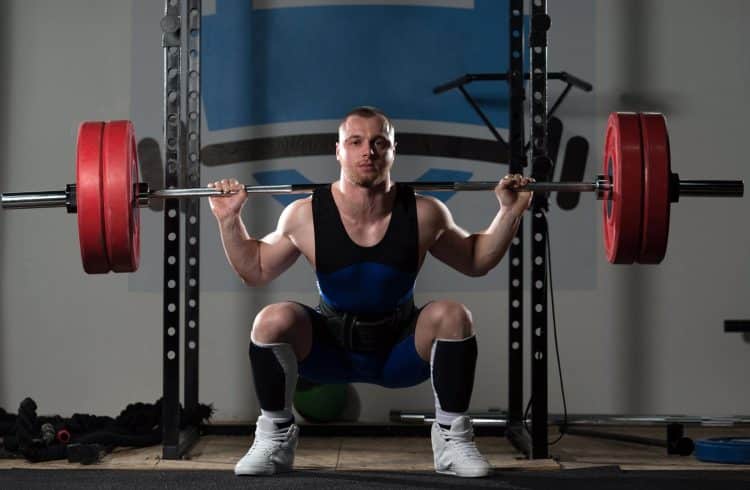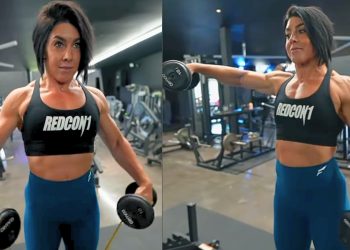Dynamic strength training exercises like squats, bench presses, and deadlifts involve three phases of muscle contraction.
Those phases are:
- Eccentric – when you lower the load, and your muscles lengthen under tension
- Concentric – when you raise the load, and your muscles shorten under tension
- Isometric – when the load is stationary and the length of your muscles is unchanged
Some exercises, like deadlifts, start with a concentric contraction, while others, such as biceps curls, begin with a concentric contraction. The isometric phase comes at the start and mid-point of each rep when your muscles are tensed, but the load isn’t moving.
It’s also possible to emphasize each phase by performing your reps in a specific way.
For example, to place more emphasis on the concentric phase, you could power clean a barbell up to your shoulders and then drop it to the floor – like many CrossFitters do to save time and energy.
Alternatively, you can lower the weight more slowly to emphasize the eccentric portion of a lift, e.g., when bench pressing.
Level Up Your Fitness: Join our 💪 strong community in Fitness Volt Newsletter. Get daily inspiration, expert-backed workouts, nutrition tips, the latest in strength sports, and the support you need to reach your goals. Subscribe for free!
Pausing at the midpoint of an exercise, such as paused squats, places emphasis on the isometric portion of the rep.
However, you can also do isometric-only training, where your only task is to tense your muscles as hard as you can without moving your joints. This is an old-school training method that still has merit today.
In this article, we discuss why and how to do isometric training and provide you with a short but effective isometric full-body workout to try.
What is Isometric Training?
Isometric training was very popular in the late 19thand early 20thcenturies, and many famous strength performers of the time practiced isometrics. They performed incredible feats of strength by statically holding huge loads in front of their adoring fans.
However, isometric training was more than just a way to demonstrate strength; it’s also a useful way to develop it.
Isometrics can also lead to greater hypertrophy or muscle size. For example, the late great martial artist Bruce Lee was a well-known proponent of isometric training and combined it with dynamic weight training in many of his workouts.
Gymnasts also do a lot of isometric work to develop the strength necessary to hold things like the iron cross on rings. Despite not training with weights, gymnasts are very muscular and phenomenally strong, which suggests that isometric training can be very effective.
Isometric training involves contracting your muscles without moving your joints. Wall squats and planks are examples of isometric exercises, and there are many other isometric exercises to choose from.
In some instances, isometric exercises involve holding your position against the pull of gravity. In contrast, in others, you push or pull against an immovable object, such as a wall, very heavy weight, or something like a yoga strap.
You can do low-intensity but long-duration isometric holds or high-intensity but short-duration holds based on your preferences and training goals.
The Benefits of Isometric Training
Other than wall squats and planks, you probably won’t see many people practicing isometrics, and that’s a shame because it’s a very effective training method. Benefits of isometric training include:
Minimal equipment required
While some isometric exercises require straps or an immovable object, many can be done without any equipment at all. As such, you can train almost anywhere and anytime, making isometrics perfect for home and traveling exercisers.
Joint-friendly
Repetitive movements cause wear and tear to your joints. It’s no coincidence that many longtime lifters often suffer from knee, hip, shoulder, and elbow pain.
However, most isometric exercises place less stress on your joints, so it may be better for some exercisers than dynamic strength training. Isometric exercises are often used by physical therapists in prehab and rehab routines. You can also pick and choose your joint angle during isometrics to avoid any positions that cause pain.
Build muscle
Despite not involving any movement, isometric training has the potential to build muscle. For example, in rat studies, isometrics resulted in similar levels of hypertrophy or muscle growth to isotonic (concentric and eccentric) training (1).
Even if human isometric studies are a little thin on the ground, the physiques of old-school strongmen suggest that isometric training is pretty good for building muscle.
Increased strength
Isometrics make you stronger because you can contract your muscles to their volitional limit and recruit the maximal number of muscle fibers (2). For this reason, some lifters perform isometrics to target their sticking points in movements like the squat, deadlift, or bench press.
To do this, simply load up a very heavy weight and put it in a squat rack at the height you want to work on. Get under the bar and push against the immovable load as hard as you can for 5-10 seconds.
Recruit more motor units for better workouts
Doing isometrics before dynamic strength training can help fire up your muscles so you can perform the dynamic exercise better. Isometric training teaches your nervous system to “turn on” more motor units so you can generate more force.
For example, doing something like an intense isometric wall squat a few minutes before barbell back squats will fire up your entire lower body.
Better mind-muscle connection
Developing a muscle is tough if you can’t feel it working. This is called the mind-muscle connection. Isometrics force you to really focus on the muscle you’re training, which can have a positive carryover to isotonic exercises.
For example, if you can’t feel your pecs working during bench presses, some isometric chest training would help strengthen the connection between your mind and muscles.
Increased joint stability
Isometric exercises force you to lock your joints into one position, eliminating instability. This will teach you to keep your joints stable during dynamic strength training exercises. In many cases, a lack of stability will reduce the effectiveness of whatever exercise you are doing.
For example, if you wobble during squats, you won’t be able to lift as much weight or do as many reps. Better stability means less wasted energy and a safer, more productive workout.
Training variety
Fitness trainers have a saying; if you always do what you have always done, you’ll always get what you always got. While this might just sound like nothing more than a silly tongue twister, it actually sums up what happens if you stick to the same program and exercises for too long.
In simple terms, your body adapts and plateaus, and your progress will grind to a halt. You can use isometrics to add a new twist to your workouts and keep on gaining muscle mass and strength.
Like barbells, dumbbells, machines, rep ranges, rest periods, and different splits, isometric training is something else you can add to your workouts to maintain productivity.
Shorter workouts
2-3 sets of 10-15 seconds are all you need to benefit from isometric training. Of course, you can do more if you wish, but even very brief isometric workouts can produce positive results. Added to the fact that you don’t need much if any equipment, isometric training is perfect for anyone who’s short on time for exercise.
Related: 5-10 Minute Workouts For Time-Pressed Exercisers
Isometric Training – Downsides
While isometric training is mostly beneficial, there are a couple of drawbacks to consider, too:
Not very quantifiable
With dynamic strength training, you can easily quantify your workout by taking note of the weight you are lifting and counting your sets and reps. However, with isometrics, there are no such measures to record, so it’s much harder to see if you are improving.
Level Up Your Fitness: Join our 💪 strong community in Fitness Volt Newsletter. Get daily inspiration, expert-backed workouts, nutrition tips, the latest in strength sports, and the support you need to reach your goals. Subscribe for free!
That said, you should be able to feel that you are contracting your muscles harder, and if you combine isometrics with dynamic isotonic strength training, your performance in the latter should improve.
Some exercisers use things like weighing scales and devices called dynamometers to measure how much force their muscles are producing, but this is not crucial, and not doing so won’t make your workouts any less effective.
High blood pressure
Blood pressure increases during all types of exercise, but especially during isometric training. This is not an issue for healthy individuals whose blood pressure quickly returns to normal. You can also limit increases in blood pressure by breathing during isometrics and never holding your breath.
However, isometrics are not suitable for people with hypertension (clinically high blood pressure), as it could make a bad situation worse.
Strength gains are angle specific
While isometrics will make you stronger, those strength gains are greatest 15 degrees above and below the angle at which you are training. So, if you hold a wall squat with your knees bent at 90 degrees, you’ll mainly build strength from 75 to 105 degrees of knee flexion and not the full range of motion.
This problem is easy to avoid by doing holds at different joint angles to develop strength through a wider range of motion. For example, if you do three sets, perform each one in a slightly different position.
Sample Isometric Exercises
You can turn almost any dynamic strength training exercise into an isometric exercise simply by stopping mid-rep and holding that position. That said, some exercises are better than others for building muscle and strength with isometrics.
Here are some sample isometric exercises to try:
1. Isometric split squat
This isometric exercise builds strength and stability at the bottom of a split squat. Use a yoga strap or towel so you have something immovable to contract your muscles against.
How to do it:
- Step forward and into a split stance. Squat down and place your yoga strap or towel under your front foot. Grip the ends tightly.
- Brace your core, pull your shoulders down and back, and tense your legs.
- Push up against the resistance offered by the towel. Contract your front leg as hard as possible for as long as you can. Take care not to hold your breath.
- Relax, swap legs, and repeat.
2. Reverse plank
The reverse plank is a fantastic exercise for your entire posterior chain. It’s a great way to undo the effects of chronic sitting, as it also stretches the muscles in the front of your body. While you can do this exercise dynamically for reps, it works much better when done isometrically.
How to do it:
- Sit on the floor with your legs straight and hands a few inches behind your hips, fingers pointing forward.
- Press your shoulders down and back and straighten your arms, so your butt is a few inches off the floor.
- Extend your hips and lift your chest up, so your body forms a straight line. Look straight up toward the ceiling.
- Tense your hamstrings, glutes, lower back, and upper back tightly and hold until your muscles begin to fatigue.
3. Isometric chest press
Do this exercise before push-ups or bench presses to fire up your pecs. Alternatively, do it anytime you need a quick, shoulder-friendly pec workout, e.g., at home or on vacation.
How to do it:
- Hold a towel or yoga strap behind your back, and then grab the ends with your hands just in front of your chest.
- Without holding your breath, try to push your arms forward as hard as possible. Keep your upper arms into your sides and flex your lats to maximize muscle engagement.
- Adjust the length of your strap to work your pecs from different angles.
4. Isometric doorway lateral raise
Build stronger, wider, healthier shoulders with nothing more than a doorframe and some intense muscular effort!
How to do it:
- Stand in an open doorway with your feet about shoulder-width apart. Place the backs of your hands against the inside of the doorframe, arms by your sides.
- Flex your deltoids and press your hands outward as hard as possible against the doorframe.
5. Isometric seated row
This exercise is a great way to turn on your lats before your next back workout. Using just a towel, this is also a decent back and biceps exercise for anyone who trains at home and can’t do pull-ups.
How to do it:
- Sit on the floor with your legs extended in front of you. Loop a towel or yoga strap over your feet and then grab the ends. Sit up tall and pull your shoulders down and back.
- Without holding your breath, tuck your arms into your sides and bend your elbows as hard as possible. Squeeze your shoulders down and back throughout.
- You can also do this exercise while sitting on a bench or chair and your feet on the floor. This may be more comfortable for some people.
6. Isometric biceps curl
You can do isometric biceps holds using dumbbells. Still, the exercise is equally effective when you do it with a towel or yoga strap. In fact, using a towel means you can contract your biceps even harder than you would with dumbbells.
How to do it:
- Kneel on the floor and place your yoga strap or towel under your knees. Hold the ends in your hands, arms by your sides.
- Keeping your shoulders down and back and core braced, try to bend your arms against the tension of the towel/yoga strap. Contract your biceps as hard as possible for as long as you can.
7. Isometric ring dip hold
Ring dips are a demanding exercise that works your entire upper body. However, it may be too challenging for some exercisers.
This isometric variation is still pretty hard, but with no movement to worry about, you can focus on tensing your chest, deltoids, and triceps and building the strength needed to do full ring dips. You can also do this isometric exercise on parallel bars, but it won’t be as demanding.
How to do it:
- Set your rings so that, when you are standing on the floor and holding them, your arms are almost straight.
- Grip the rings with your hands facing inward. Tuck your elbows tightly into your sides and brace your abs. Push your shoulders down and back.
- Maintaining upper body tension, lift your feet a few inches off the floor and hold this position for 20-30 seconds.
- You are ready to try full ring dips when you can do 3-4 sets of 30 seconds.
8. RKC planks
The aim of most plank exercises is to hold the position for as long as you can. While that’s fine for beginners, more advanced exercisers will soon get bored of planking for five minutes or more!
So, to make planks hard again, set a time limit, e.g., 20 seconds, and tense your muscles as hard as possible so you fatigue sooner. This is called the Russian Kettlebell Challenge or RKC plank.
With the RKC plank, you don’t just tense your abs but your entire body – glutes, quads, chest, shoulders, and arms.
You can read more about this unique exercise here.
Full-Body Isometric Workout
You can use isometric exercises in your warm-up to fire up your muscles or do them as finishers to completely exhaust the muscles you’ve just trained with more conventional exercises.
Alternatively, you can do stand-alone isometric workouts whenever you are unable to make it to the gym or as an alternative to lifting weights.
Here is a full-body isometric workout to try!
Contract your muscles as hard as possible and try to reach failure in 20-30 seconds. If you can go for longer, you aren’t contracting your muscles hard enough. However, a couple of exercises combine isometrics with dynamic movements, and these should be performed as described below.
| # | Exercise | Sets | Rest |
| 1 | Iso-dynamic split squat | 2-3 | 45-60 seconds |
| 2 | Isometric reverse plank | 2-3 | 45-60 seconds |
| 3 | Iso-dynamic push-up | 2-3 | 45-60 seconds |
| 4 | Isometric seated row | 2-3 | 45-60 seconds |
| 5 | Isometric doorframe lateral raise | 2-3 | 45-60 seconds |
| 6 | Isometric biceps curl | 2-3 | 45-60 seconds |
| 7 | RKC plank | 2-3 | 45-60 seconds |
Iso-dynamic exercise instructions
Iso-dynamic exercises combine dynamic movements with timed isometric holds. This is a fun and unusual way to challenge your muscles and make even simple bodyweight and freeweight exercises much more challenging.
This workout has two iso-dynamic exercises, but you can apply this training system to many other movements.
Iso-dynamic split squat
- Step forward and into a split squat stance. Your torso should be upright. Brace your core and look straight ahead.
- Bend your legs and lower your rear knee to the floor. Stand back up and repeat. Continue for 15 seconds.
- Next, descend and hold your knee an inch off the floor for 15 seconds. Keep your muscles tight, focusing on driving your foot into the floor to generate maximum muscle tension.
- Then do ten seconds of dynamic reps, followed by a ten-second hold with your knee hovering just above the floor.
- Finish with a final five seconds of dynamic reps and a five-second hold.
- Rest a moment, swap legs, and repeat.
Iso-dynamic push-up
- Adopt the push-up position with your arms straight, core braced, and legs extended.
- Bend your arms and lower your chest to the floor. Push yourself back up and repeat. Continue for 15 seconds.
- Next, descend and hold your chest an inch off the floor for 15 seconds. Keep your muscles tight, focusing on squeezing your arms in close to your sides and driving your palms into the floor to generate maximum muscle tension.
- Then do ten seconds of dynamic reps, followed by a ten-second hold with your chest hovering just above the floor.
- Finish with a final five seconds of dynamic reps and a five-second hold.
Here’s a video of the iso-dynamic push-up:
Isometrics – Wrapping Up
Isometric training was once a very popular training method. Golden-era strongmen and bodybuilders used isometrics to build phenomenal static strength and impressive levels of muscle size.
Ultimately, providing that you do isometrics often enough and contract your muscles hard enough, it can help you build strength and muscle size, and could even help you avoid joint injuries.
So, why is isometrics less popular nowadays?
It’s probably because most static hold exercises aren’t very entertaining to watch, especially when compared to videos of guys curling 220lbs! Plus, with no equipment required, it’s also hard to monetize.
None of that means that isometric training isn’t valuable. Even if you only do an exercise or two to fire up your muscles before a workout, you’ll soon find out how effective isometric training can be.
References:
1 – PubMed: Skeletal muscle hypertrophy in response to isometric, lengthening, and shortening training bouts of equivalent duration https://pubmed.ncbi.nlm.nih.gov/15075307/
2 – PubMed: Isometric training and long-term adaptations: Effects of muscle length, intensity, and intent: A systematic review https://pubmed.ncbi.nlm.nih.gov/30580468/
















